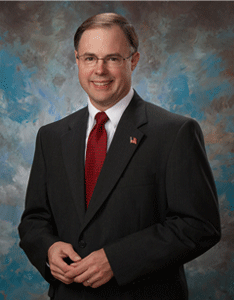South Dakota PUC chairman sees volume of rate cases hitting “crescendo level”

The rising number of rate cases being submitted to the South Dakota Public Utilities Commission (PUC) in recent years is mainly the result of an increase in capital spending by utility companies trying to reduce the environmental impact of power generation, South Dakota PUC Chairman Chris Nelson recently told Daily Energy Insider in an interview.
The South Dakota PUC has handled an average of three rate cases a year over the last 40 years, determining if increases in electric rates requested by utilities are reasonable. In 2014, however, the number of rate cases rose to 11, while in 2015 the PUC handled eight cases.
“It is pretty evident from the numbers and from the sheer workload that we’re going through that we are at this crescendo level of rate cases being submitted to the commission,” Nelson said. “That capital expenditure is being driven by EPA environmental regulations that are causing either the addition of pollution control equipment to existing plants or the closing of existing plants and the building of new generation facilities.”
Utilities are also seeing capital expenditures rise for transmission line projects and substation rebuilds.
Going forward, Nelson sees economics changing how energy is produced in South Dakota and across the country.
“As the cost of producing renewable energy comes down in solar and wind – as they come down dramatically – all of a sudden the utility companies and individuals are saying that this is the most economical way of producing electricity and that is where our next investment is going to be,” Nelson said.
The Minneapolis-based Geronimo Energy is starting construction of a 1 megawatt solar facility in Pierre, the capital city of South Dakota. Nelson said that it is the first real utility-scale solar project being developed in the state, and one that is probably the beginning of a trend.
Currently, 75 percent of the generation in South Dakota is carbon free, with much of that coming from hydro electric, some from wind, and increasingly now from solar.
Nelson also said that the commission is closely watching legal proceedings pertaining to the U.S. Environmental Protection Agency’s Clean Power Plan, which aims to reduce carbon pollution from power plants. The Supreme Court stayed implementation of the Clean Power Plan in February pending judicial review.
If the rule is upheld, the PUC will work with the South Dakota governor’s office and Department of Environment and Natural Resources, which would ultimately craft the state’s implementation plan.
“We will be working with them to make sure that whatever the ultimate compliance configuration is, that it has the least cost impact for South Dakota consumers,” Nelson said.
An unwelcome outcome of the rule may be a battle that ensues between investor-owned utilities (IOUs) and cooperative utilities in South Dakota over the allowances for CO2 emissions that will be set out in the state implementation plan.
“In this state we have generation owned by IOUs and we have generation owned by the cooperatives system and how those allowances are allocated will mean tremendous dollar expenditures by the customers of each of those systems,” Nelson said. “It is highly unfortunate that the rule pits those two groups of consumers against each other in the compliance mode.”
Nelson, a Republican, is running for re-election for a six-year term as chairman of the commission. He says his No. 1 priority if re-elected is to keep utility rates as low as possible.
“We are in an environment and a time in history when there is a lot of upward pressure on rates and a lot of challenges there, and I am committed to doing everything I can at each step of the way to try to minimize that and to keep costs under control for the citizens of South Dakota,” Nelson said.
